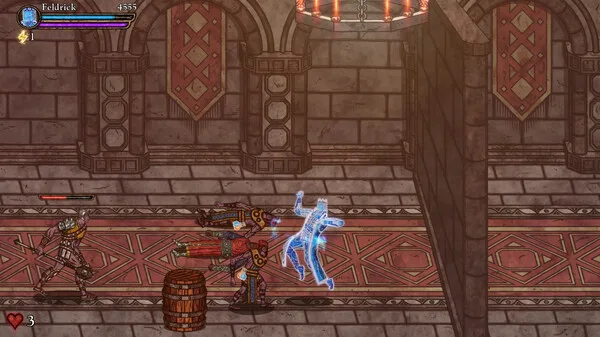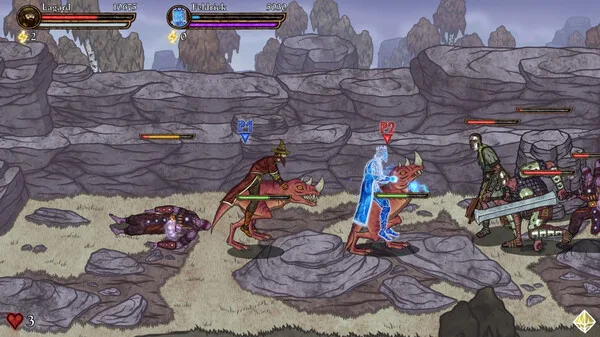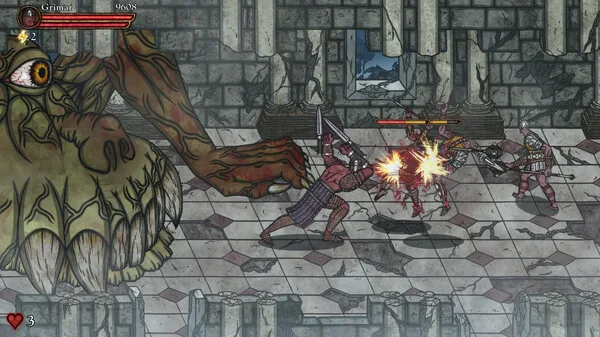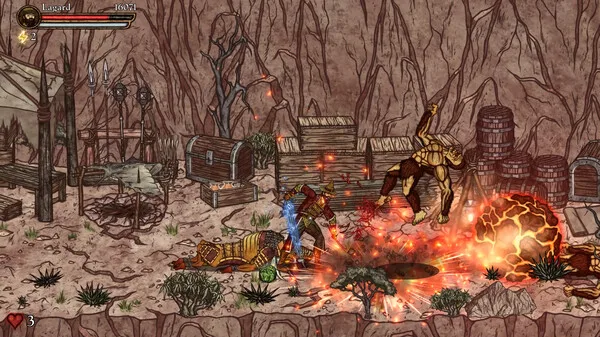Introduction
King’s Blade is a gritty side-scrolling beat ’em up rooted in sword-and-sorcery pulp and arcade tradition. If Golden Axe had a dark fantasy cousin raised on Conan the Barbarian and Streets of Rage, this would be it. Developed with a retro soul but modern execution, King’s Blade delivers high-impact brawling, six unique heroes, AI-assisted co-op, and a grimy world full of blood, bone, and steel.
But behind its pixelated fury lies a divisive beast. Some players call it a sleeper hit. Others bounced off the brutal difficulty spikes and demanding combat rhythm. What remains undisputed is that King’s Blade dares to challenge the casual flow of modern beat ‘em ups—with satisfying results for those who stick around.

Gameplay: Brawling with Bite
At its core, King’s Blade is a 12-stage medieval gauntlet where you and up to three friends (or bots) tear through legions of the Barganian Empire. Every level brings new enemy types, mini-bosses, and hidden surprises—from allies joining you in early missions to environmental ambushes that keep the experience fresh.
Where many beat ‘em ups settle for button-mashing, King’s Blade demands spacing, awareness, and intention. You can’t just spam attacks and expect to win. If you’re not lined up on the vertical axis, your sword swings through air. The enemy AI punishes carelessness, and even the “easy” difficulty has teeth—complete with lengthy, unskippable stages that can push unprepared players into frustrating loops.
Checkpoints exist, but they’re sparse. Dying before the first one? Back to square one. That said, tension builds in a rewarding way. Surviving long stretches with limited lives adds weight to every punch thrown and every dodge missed.

Combat System: Depth Over Flash
Combat is deceptively deep. Each of the six heroes plays differently—some are agile and combo-heavy, others are tanky brawlers that emphasize parries and crowd control. There’s no universal “meta” character, which pushes you to learn individual styles and matchups. The combo system isn’t overly complex, but it rewards rhythm and spacing.
And this isn’t just “punch until they fall.” Power-ups (like flame swords or magic scrolls), environmental hazards, and special attacks create layers of tactical choice. Enemies themselves are brilliantly designed—support units in the backline buff others, invisible assassins punish complacency, and hounds charge your formation in ways that disrupt flow if you’re not paying attention.
One standout feature is pre-battle preparation. Strong items are often placed right before hard encounters. Learning when and how to use them (or save them) introduces a puzzle-like rhythm that rewards repeated runs and mastery.
Visuals: Retro Violence with Style
The pixel art in King’s Blade isn’t flashy, but it’s confident. There’s a consistent dark fantasy aesthetic—think bleak hills, ruined fortresses, and torchlit interiors. Foreground animations like enemies swinging on ropes or crumbling bridges add immersion without distracting from gameplay.
Enemy designs are standout: grotesque, varied, and brimming with personality. Stages evolve meaningfully from one to the next, offering new visual themes and mechanics instead of rehashing tilesets.
However, level layouts can feel a bit “corridor-like,” especially in early stages. You’re often just walking forward for long stretches without much environmental interaction beyond the enemies.

Audio: Steel, Screams, and War Drums
The soundtrack blends retro chiptune with dark ambient and tribal war drums—perfectly matched to the setting. While it doesn’t steal the spotlight, it amplifies the tension. Hits land with satisfying crunch, and sound cues (like enemy roars or item pickups) are clean and functional.
Some may wish for more musical variation in longer stages, but what’s here carries weight and flavor.
Pros
- Tactically rich combat: Requires spacing, positioning, and weapon mastery over button mashing.
- Deep enemy variety: Enemies act differently and escalate in complexity across stages.
- Solid co-op integration: Bots or friends can jump in for local 4-player mayhem.
- Hidden unlocks and secrets: Encourages replayability and exploration.
- Smart challenge curve (on higher difficulties): Forces adaptation and skill growth.
Cons
- Sparse checkpointing: Dying before a checkpoint resets the whole level—frustrating in long stages.
- Combat learning curve: Players used to more forgiving brawlers may struggle initially.
- AI allies hog items: Bots can grab critical health or power-ups before you can react.
- Lack of save mid-level: No way to save progress mid-stage if you quit or crash.
- Occasional level design monotony: Some environments feel like long, flat hallways.
Verdict: A Gritty Gem with Sharp Edges
King’s Blade doesn’t hold your hand. It throws you into a brutal world of steel and sorcery, asks you to learn its rhythm, and rewards you for staying on your feet. While it lacks modern quality-of-life polish and has a few pacing stumbles, its crunchy combat, enemy variety, and co-op options make it a standout in the beat ’em up genre.

For fans of Golden Axe, Sengoku, or even Dark Souls combat pacing, this is a must-try indie sleeper. Just know what you’re getting into—and don’t expect an easy ride.
Score: 6.5/10 – Brutal, beautiful, and refreshingly unforgiving.
King’s Blade: King’s Blade is a stylish and challenging beat ’em up with deep combat, solid enemy variety, and a gritty fantasy aesthetic—but it’s held back by outdated design choices. Long, unforgiving levels with no mid-stage saves make repetition feel punishing rather than rewarding. It’s a rewarding brawler for the stubbornly hardcore, but a frustrating grind for everyone else. – Mario Vasquez